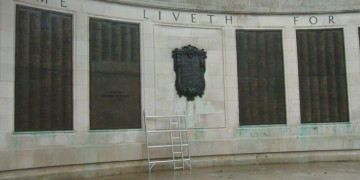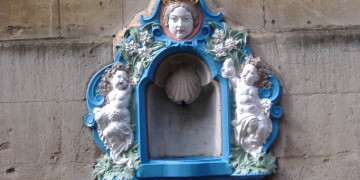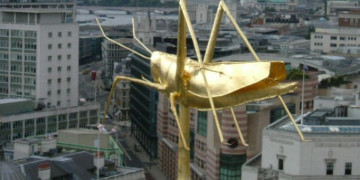Case study: The London Hippodrome Statue
Restoration of this roof-top cast iron statue situated in the heart of London on the corner of Leicester Square. The Hippodrome, built in 1900, was a venue for circus and variety performances.
The building had recently undergone a refurbishment of its façade, and the client employed Dorothea Restorations to restore the monumental cast iron statue of a charioteer that sits on the roof.
The statue, originally cast by the Saracen foundry of Walter MacFarlane in Glasgow, needed extensive cleaning and some minor repairs. This was carried out by our Bristol Workshops in conjunction with cleaning works to the building’s façade. Finally, the cast iron statue was then painted bronze using the Ardenbrite paint system to finish.
A Brief History of the Hippodrome
Built by Frank Matcham, a theatrical architect and designer, as a venue for circus and variety performances, the Hippodrome gave its first show in 1900, debuting the later to be great Charlie Chaplin. Internally, the Hippodrome featured an arena that could be turned into a 100,000-gallon water tank for aquatic acts adorned with more than 10 fountains around the edges and was regularly filled with exotic animals, elephants and acrobats.
Later, in 1909, Matcham redeveloped the building into a music hall capable of seating an audience of over 1300. Clearly a contemporary of its times, The Hippodrome featured the first official jazz concert in the UK. Alas, the original interior was demolished in 1958, and the Hippodrome was turned into a nightclub.
Fortunately, MacFarlane’s statue remained intact on top of the Hippodrome and in 2009, the lease was acquired by a couple of entrepreneurs who undertook an extensive restoration plan to convert the Hippodrome back to the original design by Matcham.
Walter MacFarlane’s Ironworks
Macfarlanes, a.k.a. The Saracen Foundry, was arguably one of the most monumental producers of ornamental ironwork in Scotland. Walter Macfarlane 1 started life as a jeweller before serving an apprenticeship in blacksmithing. After a decade of ironwork for other foundries, Macfarlane founded his own company in Glasgow in 1850.
Macfarlane's specialised in the production of drinking fountains, bandstands, lamp standards, pre-fabricated buildings and architectural metalwork ornament, with an emphasis on elegance. The firm mass-produced patterns designed by prominent Glasgow architects.
Due to his popularity, Macfarlane moved to a purpose-built foundry on the former Possil Estate in 1872, creating Possilpark covering 14 acres of land, which in turn became a suburb of Glasgow in its own right. Built to house The Saracen Foundry’s expanding workforce, astonishingly, the population grew 1000 fold between 1872 and 1891 into a community of 10,000. On Macfarlane’s death, his nephew, also named Walter, succeeded to the firm.
Sadly, an incredible amount of The Saracen Foundry’s ironworks were destroyed during World War II. Iron, now a vital material for wartime industry, was requisitioned by the Ministries of Supply and Production, leading to the destruction of much of Macfarlane’s architectural and ornamental ironwork across the UK.
Macfarlane's was eventually taken over by Allied Founders in 1965, which was later absorbed, and the Possilpark foundry was demolished in 1967, leading to the complete degradation of the urbanised area.







